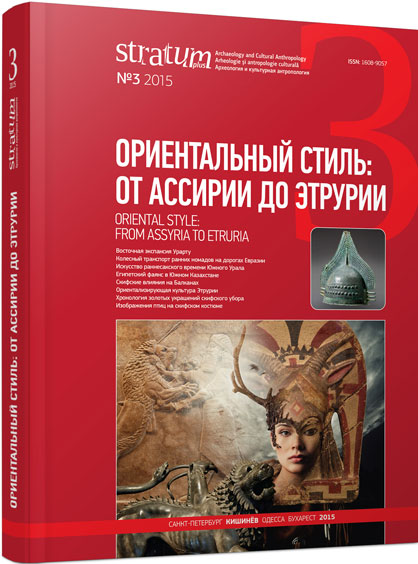Хронология и распространение золотых нашивных бляшек в раннескифское время (VIII—VII вв. до н. э.)
About the Dating and Distribution of Golden Robe-Appliques in the Early Scythian Period (8th—7th centuries BC)
Author(s): Anja Hellmuth KrambergerSubject(s): History, Archaeology, Fine Arts / Performing Arts, Cultural history, Visual Arts, Ancient World
Published by: Издательский дом Stratum, Университет «Высшая антропологическая школа»
Keywords: Early Scythian culture; Golden appliques; women’s costumes; chronology; contacts between the Near East and the Eastern Hallstatt region
Summary/Abstract: As a characteristic of the Scythian cultural-circle the custom can be described to decorate clothes, weapons and horseharness, quivers and vessels of wood and ceramics with small golden appliques. In this paper on the one hand the dating of those Kurgans with golden appliques in the Early Scythian Period (8th—7th century BC) shall be discussed, and on the other hand the distribution of finds in the North Pontic Region and in the neighboring and more distant regions as well. Because it can be established, that identical golden appliques as in kurgans of the Middle Dnieper and the North Caucasus occur also in the Eastern Hallstatt region in grave finds of the late 8th/early 7th century BC, primarily in the Slovenian Doljensko. For some of the findings of gold appliques based on the archaeological findings we can establish that they were placed as ornaments on headdresses, and anthropological studies show that in the majority, these are the burials of women. The golden appliques were apparently reserved for a group of women of a special status. Parallels in the Near East as in the royal tombs at Nimrud/Kalhu can be pointed out. According to inscriptions, they belonged to Assyrian queens and we can interpret the outstanding female burials of the North Pontic region in a similar way as queens or priestesses. Maybe even some of the burials represent the exchange of women to stabilize political alliances.
Journal: Stratum plus. Археология и культурная антропология
- Issue Year: 2015
- Issue No: 3
- Page Range: 143-166
- Page Count: 24
- Language: Russian
- Content File-PDF

